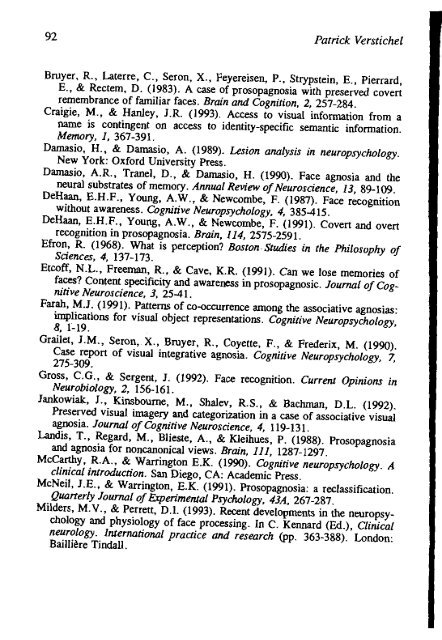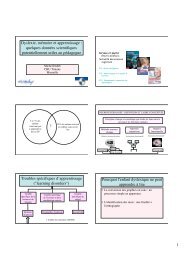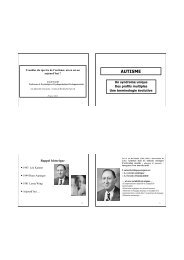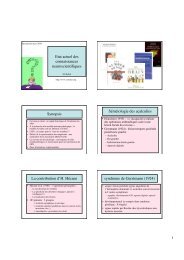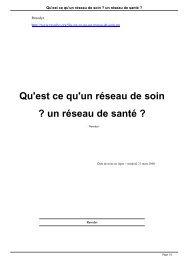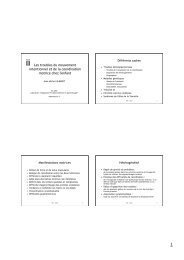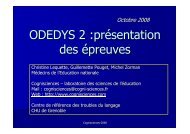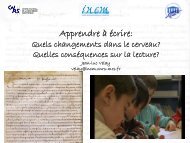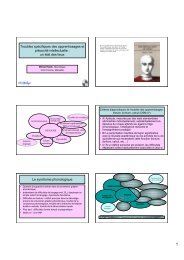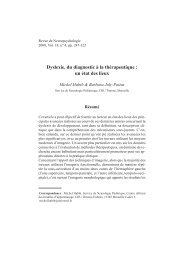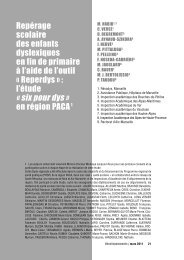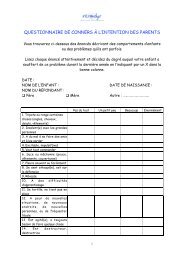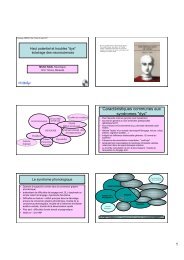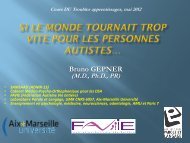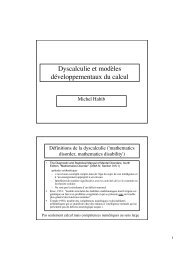Reconnaissance implicite des visages par stimulation de l ... - RNP
Reconnaissance implicite des visages par stimulation de l ... - RNP
Reconnaissance implicite des visages par stimulation de l ... - RNP
- No tags were found...
Create successful ePaper yourself
Turn your PDF publications into a flip-book with our unique Google optimized e-Paper software.
~ ~~~-~Patrick VerstichelBruyer, R., Laterre, C., Seron, x., Feyereisen, P., Strypstein, E., Pierrard,E.. & Rectem, D. (1983). A case of prosopagnosia with preserved covertremembrance of familiar faces. Brain and Cognition, 2, 257-284.Craigie, M., & Hanley. J.R. (1993). Access to visual information from aname is contingent on access to i<strong>de</strong>ntity-specific semantic information.Memory, 1, 367-391.Damasio, H., & Damasio, A. (1989). &sion analysis in neuropsychology.New York: Oxford Universitv 2 Pres -Damasio, A.R., Tranel, D., & Damasio, H. (1990). Face agnosia and theneural substrates of memory. Animal Review of Neuroscience, 13, 89-109.DeHaan, E.H.F., Young, A.W., & Newwmbe, F. (1987). Face recognitionwithout awareness. Cognitive Neuropsychology, 4, 385-415.DeHaan. E.H.F.. Young, A.W., & Newwmbe, F. (1991). Covert and overtrecognition in prosopagnosia. Brain, 114, 2575-2591.Efron, R. (1968). What is perception? BostonStudies in the Philosophy ofSciences, 4, 137-173.Etcoff, N.L. Freeman R ,& Cave. K.R. (1991). Cm we lose memories offaces? Content specificity and awareness in prosopagnosic. Journal of CognitiveNeuroscience, 3. 25-4 1.Farah. M.J. (1991). Patterns of w-occurrence among the associative agnosias:implications for visual object representations. Cognitive Neuropsychology,8 1-19Gross, C.G., & Sergent, J. (1992). Face recognition. Current Opinions inNeurobiolom. ",, 2. -, 1 --- 56-1 AI--A.Jankowiak, I., Kinsboume, M., Shalev, R.S., & Bachman, D.L. (1992).Preserved visual imagery and categorization in a case of associative visualagnosia. Journal of Cognitive Neuroscience, 4, 119-131.Landis, T., Regard, M.. Blieste, A., & Kleihues, P. (1988). Prosopagnosiaand agnosia for noncanonical views. Brain, 111, 1287-1297.McCanhy, R.A., & Warrington E.K. (1990). Cognitive neuropsychology. Aclinical introduction. San Diego, CA: Aca<strong>de</strong>mic Press-~ ~McNeil. J.E., & Warrington, E.K. (1991). Prosopagnosia: a reclassification.Quarterly Journal of Experimental psycho log^, 43A. 267-287.Mil<strong>de</strong>rs, M.V., & Perrett, D.I. (1993). Recent <strong>de</strong>velopments in the neuropsychologyand physiology of face processing. In C, Kennard (Ed.). Clinicalneurology. International practice and research W. 363-3881, London:Bailli&re Tindall.Prosopagnosie et reconnaissance <strong><strong>de</strong>s</strong> <strong>visages</strong> 93Newcombe, F., Young, A.W., & DeHaan, E.H.F. (1989). Prosopagnosia andobject agnosia without covert recognition. Neuropsychologia, 27, 179-191.Og<strong>de</strong>n, J.A. (1993). Visual object agnosia, prosopagnosia, achromatopsia,loss of visual imagery, and autobiographical anmesia following recoveryfrom cortical blindness: case M.H. Neuropsychologia, 31, 571-589.Renault, B., Signoret, J.L., Debruille, B., Breton, P., & Bolgert F. (1989).Brain notentials reveal wvert facial recognition - in orosopagnosia. Neuropsych~logia,27, 905-912.Riddoch, M.J., & Humphreys, G.W. (1987). A case of integrative agnosia.Brain, 110, 1431-1462.Sergent, J. (1982). About faces: lefi-hemisphere involvement in processingphysiognomies. Journal of . Experimental . Psycholoay: -. Human Perceptionand ~erformance, 8, 1-14.Sergent, 1. (1984). Configurai processing of faces in the left and the rightcerebral hernispheres. Journal of ExperinIental Psvchology: Human Perceptionand ~eÕrformance 10. 554-572.Sergent, 1. (1988) Face perception and the right hemisphere. In L. Weiskrantz(Ed.). . .. Thourht without lanruafe - (m. -- 109-131). Oxford: OxfordUniversity PI&.Sergent, J., & Poncet, M. (1990). From covert to overt recognitionof faces ina prosopagnosic patient. Brain, 113, 989-1004.Tranel, D., & Damasio, A.R. (1988). Non conscious recognition in patientswith agnosia. Behavioural Brain Research, 30, 235-249.Valentine. . T.. . Bredart. S.. Lawson. . R.. . & Ward. G. (1991). What's in aname? Access to information from - people's - &es. ~uro~ean Journal ofCognitive Psychology, 3, 147-176.Valentine, T., Moore, V., Flu<strong>de</strong>, B., Young, A.W., & Ellis, A.W. (1993).Revetition nrimine and oroper name processine. Do common names andpiGer names each other? ~emÔ? 1, 326-349.Wolpert, 1. (1924). Die Sirnultanagnosie: Stomng <strong>de</strong>r Gesamtauffassung.Zeitschriftfurdie gesamte Neurologie und Psychiatrie, 93, 397-415.Young, A.W., & DeHaan, E.H.F. (1988). Boundaries of covert recognition inpr~sopagnosia. Cognitive Neuropsychology, 5, 317-336.Youne. -. A.W.. & DeHaan. E.H.F. (1991). Face recomition- --- and awarenessafter brain injury. In A.D. Milner & M.D. Rugg (Eds.), 77le neuropsycholoey. of . consciousness and copition (pp. -. 69-90). London: Aca<strong>de</strong>micPress.Young, A.W., DeHaan, E.H.F., & Newcombe, F. (1990). Unawareness ofimpaired face recognition. Brain and Cognition, 14, 1-18.Young, A.W., & Ellis, H.D. (1989). Childhood prosopagnosia. Brain andCognition, 9, 1647.


